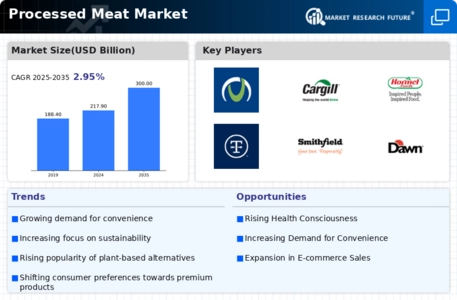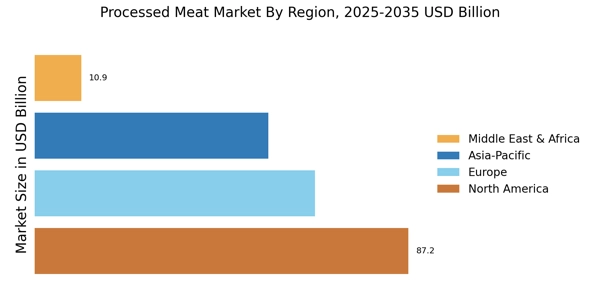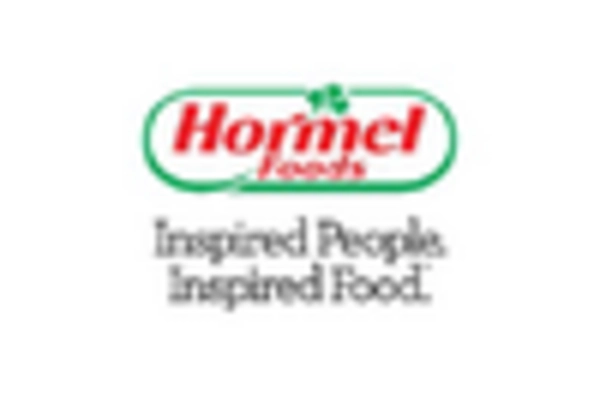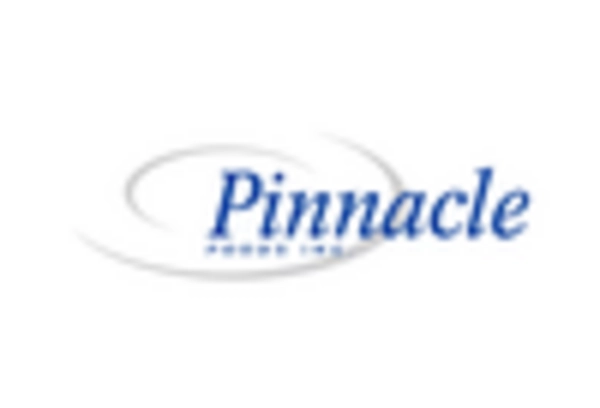Evolving Consumer Preferences
Consumer preferences are shifting towards more diverse and flavorful food options, which is a key driver in the Processed Meat Market. As globalization influences culinary tastes, consumers are increasingly seeking processed meats that reflect various cultural flavors and cooking styles. This trend is evident in the rising popularity of international processed meat products, such as spicy sausages and marinated meats. Market data suggests that this diversification in flavor profiles is attracting a broader audience, thereby expanding the consumer base for processed meats. The Processed Meat Market must adapt to these evolving preferences to remain competitive and relevant in a dynamic food landscape.
Innovative Product Development
Innovation plays a crucial role in driving the Processed Meat Market forward. Manufacturers are increasingly focusing on developing new flavors, textures, and formats to attract diverse consumer segments. This includes the introduction of gourmet processed meats and unique seasoning blends that cater to evolving taste preferences. Recent market data indicates that innovative product lines have contributed to a notable increase in sales within the processed meat sector. As companies invest in research and development, the potential for new product launches remains high, suggesting that the Processed Meat Market will continue to evolve. The emphasis on creativity in product offerings may also enhance brand loyalty among consumers.
Convenience and Ready-to-Eat Options
The increasing demand for convenience foods is a notable driver in the Processed Meat Market. Consumers are increasingly seeking ready-to-eat meals that fit their busy lifestyles. This trend is reflected in the growth of pre-packaged processed meats, which offer quick meal solutions without compromising on taste. According to recent data, the convenience food sector has seen a rise in sales, with processed meats accounting for a substantial portion of this growth. The appeal of easy-to-prepare options is likely to continue influencing consumer preferences, thereby propelling the processed meat segment further. As more individuals prioritize time-saving solutions, the Processed Meat Market is expected to adapt by expanding its range of convenient offerings.
Growing Demand for Protein-Rich Foods
The rising awareness of the importance of protein in diets is a significant driver for the Processed Meat Market. As consumers increasingly recognize the health benefits associated with protein consumption, the demand for protein-rich processed meats has surged. Data indicates that protein-rich diets are becoming more popular, with processed meats being a convenient source of high-quality protein. This trend is particularly evident among fitness enthusiasts and health-conscious individuals who seek to incorporate more protein into their meals. Consequently, the Processed Meat Market is likely to experience sustained growth as it aligns its offerings with this protein-centric consumer behavior.
Increased Focus on Food Safety and Quality
Food safety and quality assurance are paramount concerns for consumers, significantly impacting the Processed Meat Market. As awareness of foodborne illnesses grows, consumers are demanding higher standards in the production and handling of processed meats. This has led to stricter regulations and quality control measures within the industry. Recent data indicates that companies prioritizing food safety are likely to gain consumer trust and loyalty, which can translate into increased sales. The Processed Meat Market is thus compelled to enhance its safety protocols and transparency in sourcing to meet consumer expectations. This focus on quality not only addresses safety concerns but also positions brands favorably in a competitive market.


















Leave a Comment